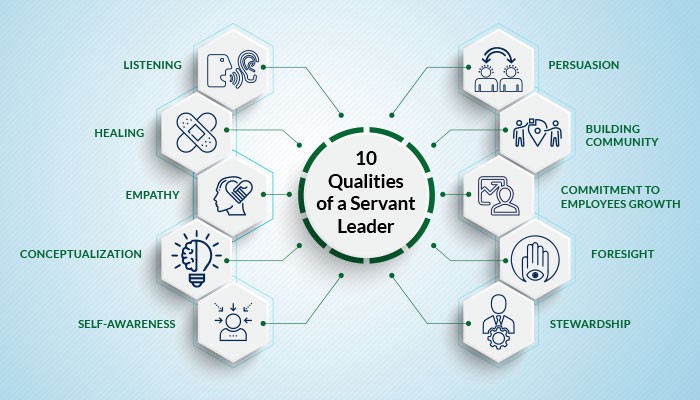Forbes Councils Member
Brian Tait
Mar 11, 2020
Credit to the image: etech
Servant leadership and traditional leadership employ different techniques and offer vastly different outcomes.
With a traditional leadership approach, the leader encourages people to do their jobs by providing them with guidance, direction and motivation.
The main focus of a traditional leader is to improve the business position of the company or the organization in the market.
The main focus of a traditional leader is to improve the business position of the company or the organization in the market.
Servant leadership occurs when the leader’s main goal and responsibility is to provide service to their people.
Servant leadership occurs when the leader’s main goal and responsibility is to provide service to their people.
A servant leader focuses on the people that are directly below them, rather than the company as a whole.
In servant leadership, the leader ensures that the followers are growing in all areas — their profession, knowledge, autonomy and even their health and physical development.
Many believe that when leaders shift their focus from the company to the employees, they are more likely to produce skilled, talented, knowledgeable and motivated employees which, in turn, will help to improve the overall operations and management of the organization.
Many believe that when leaders shift their focus from the company to the employees, they are more likely to produce skilled, talented, knowledgeable and motivated employees
which, in turn, will help to improve the overall operations and management of the organization.
This leadership style has gained immense popularity in the world and is adopted by various top-ranking companies.
One of the most prominent examples of such a business model is Google.
Google takes really good care of its employees and their employee-friendly policies have remarkably increased productivity and revenue.
Google takes really good care of its employees and their employee-friendly policies have remarkably increased productivity and revenue.
Where did the term ‘servant leadership’ come from?
The phrase “servant leadership” was coined by Robert K. Greenleaf when he used it for the first time in his essay that was published in 1970.
In his essay, Greenleaf explains the term servant leader and talks about the reason for coming up with a new leadership approach.
The popularity of the concept can further be seen in Hermann Hesse’s book The Journey to the East, where the main character Leo acts like a servant and works with them until, one day, he disappears and everyone comes to the realization that nothing is the same without him and he was not a servant but a leader.
Leo was seen as a servant throughout, but without him, the team felt lost and realized that he was their actual leader who helped everyone and brought out the best in everyone.
How can one become a servant leader?
Anyone can become a servant leader by demonstrating certain characteristics. Here’s how:
- 1.Be a good listener
- 2.Have empathy
- 3.Heal those around you
- 4.Be aware
- 5.Persuade without being forceful
- 6. Conceptualize and communicate a vision.
- 7. Channel foresight.
- 8. Practice stewardship.
- 9. Commit.
- 10. Build a community.
1. Be a good listener.
Servant leaders always listen to people before they speak their minds. They want to know what their people think and how they feel. To improve your listening skills, it is important that when you talk to people, you give them your undivided attention and notice their tone and body language while speaking.
2. Have empathy.
Servant leaders feel for their people and don’t turn a blind eye toward their problems and issues. They try hard to resolve those issues by fulfilling the needs and wants of the general public.
3. Heal those around you.
A servant leader is capable of healing people with a focus on their emotional health and a feeling of completeness. This means the leader needs to make sure that people have access to knowledge and resources that enable them to create a healthy and peaceful working environment.
4. Be aware.
Servant leaders are fully aware of themselves and their people.
5. Persuade without being forceful.
A good leader is capable of convincing people in different ways. Leaders never make use of their authority to make people do something but instead motivate and encourage people to take the desired course of action. A leader is not forceful or bossy.
6. Conceptualize and communicate a vision.
A servant leader can help build a concept for people. This includes the task of creating a vision and mission statement to provide a sense of direction for the entire team.
7. Channel foresight.
A good leader can anticipate future events and how they will impact everyone. The ability to foresee is not a god-gifted talent but rather a skill that is acquired through experience, learning and analysis of past trends. Popular business tools, such as a SWOT analysis and a PEST analysis, can be used to predict the future and make educated forecasts.
8. Practice stewardship.
Stewardship refers to accountability. It is the ability to take responsibility for the actions, behaviors and performances of your team.
9. Commit.
Good servant leaders are those whose main focus is the people, and this makes the leader fully committed to their growth and development. To develop people, it is important to analyze their needs and then cater to them accordingly.
10. Build a community.
The leader should be able to walk with and among the people, so that the leader can help them by serving and building a community.
What are the implications of service leadership?
Greenleaf believed that servant leadership was more of a lifestyle than a technique that could be implemented in one go.
Even though the concept was introduced a long time ago, it is still a relatively new concept that needs work. In fact, it was only in 2004 that the concept started to be studied formally in a proper and empirical way.
Ethics have become an important concern in the business environment.
Various research is being done on servant leadership, and the leaders who implement this style of leadership should make sure it is done honestly and ethically.
A wide range of different scales have been created to measure the magnitude of servant leadership and ethics in various organizations.
These scales were created because although servant leadership may have numerous positive aspects, its downside is that if the leader does not behave ethically, then practicing servant leadership for the benefit of the organization is pointless and a farfetched idea.
A leader who behaves unethically is likely to decrease followers’ motivation, and this can hamper business growth and development.
A leader who behaves unethically is likely to decrease followers’ motivation, and this can hamper business growth and development.
Originally published at https://www.forbes.com.
Brian Tait works with leaders to create leadership awareness and unlock limitless potential.












